#SciComm
Explore tagged Tumblr posts
Text
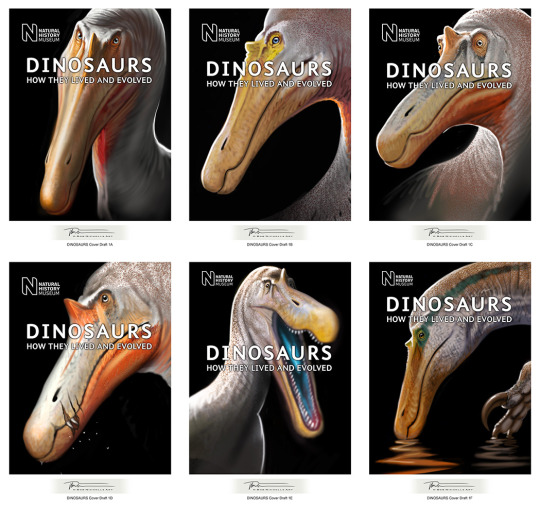

My 25 years of palaeoart chronology…
Here are my drafts drawings for the 2023 cover of DINOSAURS, HOW THEY LIVED AND SURVIVED (third edition), the official dinosaur book from the Natural History Museum, London, by Naish and Barrett.
#Art#Painting#PaleoArt#PalaeoArt#SciArt#SciComm#DigitalArt#Illustration#Dinosaurs#Birds#Pterosaurs#Reptiles#MarineReptiles#Palaeontology#Paleontology#Dinosaur#Spinosaurs#Spinosaurus#Baryonyx#Ceratosuchops#JurassicWorld#FossilFriday
154 notes
·
View notes
Text
Continuing with the late Cretaceous marine environment of southern Sweden, the huge mosasaur Tylosaurus ivoensis tries an attack from below.

#dinosaur#illustration#paleoart#paleontology#paleoillustration#paleoblr#palaeoblr#art#palaeontology#mosasaurus#tylosaurus#sweden#palaeoart#paleoartist#jurassic world#late cretaceous#prehistoric planet#scicomm#sci art#natural history#earth history#evolution#sea reptile
74 notes
·
View notes
Text
When I was in vet school I went to this one lecture that I will never forget. Various clubs would have different guest lecturers come in to talk about relevant topics and since I was in the Wildlife Disease Association club I naturally attended all the wildlife and conservation discussions. Well on this particular occasion, the speakers started off telling us they had been working on a project involving the conservation of lemurs in Madagascar. Lemurs exist only in Madagascar, and they are in real trouble; they’re considered the most endangered group of mammals on Earth. This team of veterinarians was initially assembled to address threats to lemur health and work on conservation solutions to try and save as many lemur species from extinction as possible. As they explored the most present dangers to lemurs they found that although habitat loss was the primary problem for these vulnerable animals, predation by humans was a significant cause of losses as well. The vets realized it was crucial for the hunting of lemurs by native people to stop, but of course this is not so simple a problem.
The local Malagasy people are dealing with extreme poverty and food insecurity, with nearly half of children under five years old suffering from chronic malnutrition. The local people have always subsisted on hunting wildlife for food, and as Madagascar’s wildlife population declines, the people who rely on so-called bushmeat to survive are struggling more and more. People are literally starving.
Our conservation team thought about this a lot. They had initially intended to focus efforts on education but came to understand that this is not an issue arising from a lack of knowledge. For these people it is a question of survival. It doesn’t matter how many times a foreigner tells you not to eat an animal you’ve hunted your entire life, if your child is starving you are going to do everything in your power to keep your family alive.
So the vets changed course. Rather than focus efforts on simply teaching people about lemurs, they decided to try and use veterinary medicine to reduce the underlying issue of food insecurity. They supposed that if a reliable protein source could be introduced for the people who needed it, the dependence on meat from wildlife would greatly decrease. So they got to work establishing new flocks of chickens in the most at-risk communities, and also initiated an aggressive vaccination program for Newcastle disease (an infectious illness of poultry that is of particular concern in this area). They worked with over 600 households to ensure appropriate husbandry and vaccination for every flock, and soon found these communities were being transformed by the introduction of a steady protein source. Families with a healthy flock of chickens were far less likely to hunt wild animals like lemurs, and fewer kids went hungry. Thats what we call a win-win situation.
This chicken vaccine program became just one small part of an amazing conservation outreach initiative in Madagascar that puts local people at the center of everything they do. Helping these vulnerable communities of people helps similarly vulnerable wildlife, always. If we go into a country guns-blazing with that fire for conservation in our hearts and a plan to save native animals, we simply cannot ignore the humans who live around them. Doing so is counterintuitive to creating an effective plan because whether we recognize it or not, humans and animals are inextricably linked in many ways. A true conservation success story is one that doesn’t leave needy humans in its wake, and that is why I think this particular story has stuck with me for so long.
(Source 1)
(Source 2- cool video exploring this initiative from some folks involved)
(Source 3)
#we can save the world just maybe not in the way we���d planned#long post#scicomm#conservation#lemurs#wildlife#ecology#animals#vet med#veterinary medicine#One Health
36K notes
·
View notes
Text
We are approaching the maximum of images you can post here so I thought it was time I make a little showcase of all the formation pieces we covered so far on the streams.

Chaneres Formation

Hanson Formation

Guimarota Formation

Winton formation

Holocene Madagascar

Riversleigh

Kimmeridge Clay

Tapinocephalus Assemblage Zone

Hunsrück Slate

Yixian Formation

Paja Formation

Besano Formation

Pebas megawetland

Fezouata Formation

Ngorora Formation

Kuldana Formation

Madygen Formation

Jebel Qatrani '

Holocene Cuba

Pierre Shale

Crato Formation

Archer City Formation

Tambach Formation

La Brea tar pits

Morrison Formation

Sannine Formation

Ballagan Formation

Shanwang Formation

Austrian Paratethys
For people who don't know: for several months now I draw one formation or fossil locality every Saturday. The next place we visit is chosen by a wheel of names, which we also constantly fill up again when a new formation is picked.
I try to make it as interesting as possible in my composition and choice of animals and I can tell you this series has been a great training when it comes to constructing these, how I call them, Menageries.
I have to thank a team of friends and colleagues who help behind the scenes with research, creation of size charts and conversation partners when it comes to deciding on the compositions of these pieces. Their help has been invaluable!
#paleoart#sciart#paleostream#palaeoblr#cretaceous#dinosaur#jurassic#pterosaur#sauropod#formations#miocene#eocene#triassic#devonian#carboniferous#labrea#morrison#bromacker#permian#deeptime#scicomm
14K notes
·
View notes
Text
A caveat to this study: the researchers were primarily looking at insect pollinator biodiversity. Planting a few native wildflowers in your garden will not suddenly cause unusual megafauna from the surrounding hinterlands to crowd onto your porch.
That being said, this study backs up Douglas Tallamy's optimistic vision of Homegrown National Park, which calls for people in communities of all sizes to dedicate some of their yard (or porch or balcony) to native plants. This creates a patchwork of microhabitats that can support more mobile insect life and other small beings, which is particularly crucial in areas where habitat fragmentation is severe. This patchwork can create migration corridors, at least for smaller, very mobile species, between larger areas of habitat that were previously cut off from each other.
It may not seem like much to have a few pots of native flowers on your tiny little balcony compared to someone who can rewild acres of land, but it makes more of a difference than you may realize. You may just be creating a place where a pollinating insect flying by can get some nectar, or lay her eggs. Moreover, by planting native species you're showing your neighbors these plants can be just as beautiful as non-native ornamentals, and they may follow suit.
In a time when habitat loss is the single biggest cause of species endangerment and extinction, every bit of native habitat restored makes a difference.
#nature#wildlife#animals#ecology#environment#conservation#science#scicomm#pollinators#bees#butterflies#hoverflies#insects#native plants#habitat restoration#solarpunk#hopepunk#naturecore#wildflowers#good news
6K notes
·
View notes
Text
as funny as it is to say, "there's no such thing as a fish" is not actually true
"science doesn't know what a fish is" is really not true
"fish" is not a monophyletic category. there is no common ancestor of everything that we call a "fish," and none of the things that we don't
"fish" is a paraphyletic category -- and a useful one! marine biologists use it! "fish" describes a general body plan and lifestyle. it is useful to be able to talk about coelacanths and tuna in a shared category, though coelacanths are more closely related to us than to tuna.
where this bugs me is the repetition of the idea that "scientists" are hidebound and uncreative, unable to comprehend anything that doesn't conform to a specific idea of categorization -- when this is fundamentally untrue! we know perfectly well what a "fish" is. the fact that it's a paraphyletic group is only confounding to pop science, as a funny factoid, not to anyone who actually understands what a paraphyletic group is.
#bird original#science#pop science#fish#marine biology#biology#scicomm#putting this in main tags bc it came up recently and has been itching in my brain ever since
10K notes
·
View notes
Text
i've been trying to stay off of internet and i've been active on tumblr because I'm too exhausted to do things I normally enjoy. Anyway
Animal enjoyers are mad about the slightly edited wolves that Colossal Biosciences is claiming are "dire wolves." Lots of them didn't read the articles, which would provide more information. However, the journalism about this has been god-awful anyway.
The company is concurrently working on cloning endangered red wolves and figuring out how to bring red wolf/coyote hybrids back into the red wolf gene pool, as per the Time article about it. The project includes one of the biggest names in canid genomics and evolution including pertaining to red wolves, so I am optimistic that red wolves are probably the real aim of the project and the dire wolf bullshit is just a snazzy jurassic park style tagline to snare investors.
However the grift has grifted too close to the sun as according to washington post, trump is using "de-extinction" technology as an excuse to gut the endangered species act (i can't actually read the article unfortunately). The cost of this lie could be very high if the general public thinks that bringing back an extinct species can be easily done by just going into the DNA of an animal that looks sort of similar and tweaking it.
Also somehow, even more infuriating to me, this is going to eternally fuck up the perception of what a dire wolf actually was. As per wikipedia, Aencyon dirus was not closely related to any modern wolves. It is over 5 million years separate from them. It was essentially not a "wolf" at all. You might as well try to create a dire wolf by modifying a jackal or an African wild dog. You might as well call the dire wolf a dire jackal or a dire dog.
Dire wolves were not that much bigger than wolves. They were maybe 20% bigger and their size range overlaps with the northern-most wolves of today.
Even the articles critical of the supposed "de-extinction" are fucking it up! The not-actually-legit "dire wolf" puppies have white fur, and the journalists are uncritically repeating the idea that dire wolves were white, when that isn't something we know about them. The white fur is based off of the fantasy creature of the same name in Game of Thrones.
That's just flat-out embarrassing.
2K notes
·
View notes
Text
I'm a squid biologist on a mission
To bring squid facts to you. To your friends. To your neighbors. To some random dude named Brad who you've never met.
How? The Squid Facts Project. It's a street art campaign and hotline that texts folks squid facts!

Only snag in this hair-brained plan is that texting people is kiiinda expensive. So! I teamed up with Philly artist Corey Danks to sell shirts to keep the hotline running. Every one of those shirt dollars helps deliver squid facts to people.
Like, over 70,000 people over the last year!!! Isn't that wild?
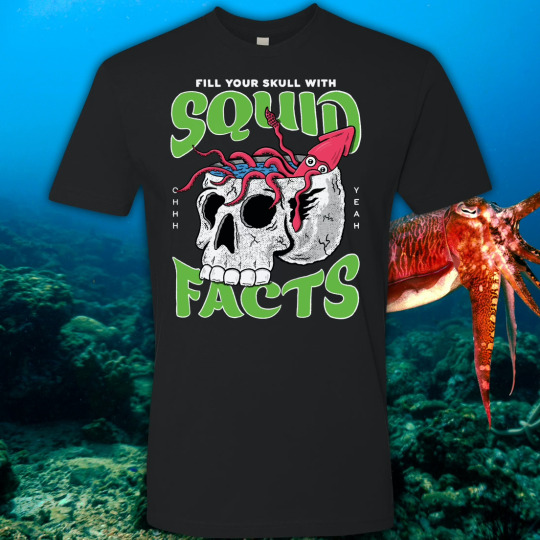
So anyway. Get a shirt. They're cool, *and* they keep people learning about squid. It's a beautiful thing.
Also, the backs have the squid facts hotline on them so by wearing these you're helping people learn about squid too.
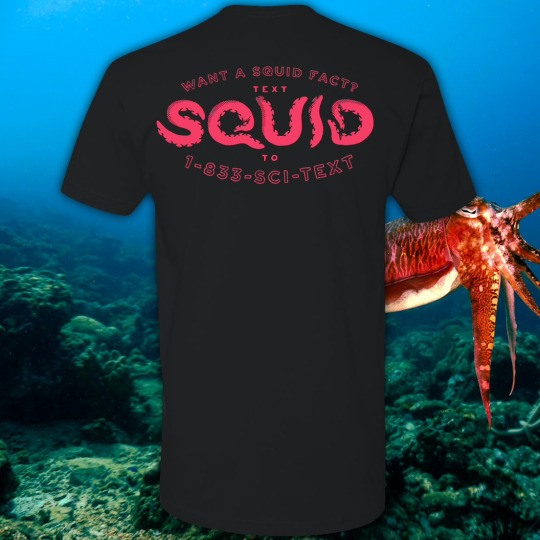
If you can't buy one, give us a reblog. I run a small science education nonprofit called Skype a Scientist, we're scrappy but trying so hard!!
#Squidtember#Squid#Cephalopods#science#marine biology#cephalopod#scicomm#sealife#marine life#squid facts#A lovely outfit for you#educational outfits?
8K notes
·
View notes
Text
a guide to the exoparia
the presence of the exoparia doesnt actually change much for the way we reconstruct most dinosaur groups, however, it changes some minor things for two of the most well known dinosaur groups that should be taken into account:




link to paper: onlinelibrary.wiley.com/doi/full/10.1111/joa.14242
#paleoart#digital art#paleontology#digital artwork#artists on tumblr#palaeoart#digital illustration#sciart#id in alt text#dinosaur#alt text#guide#tutorial#exoparia#tyrannosaur#ceratopsian#scicomm#science communication
914 notes
·
View notes
Text
In England Have My Bones [T.H.] White wrote one of the saddest sentences I have ever read: ‘Falling in love is a desolating experience, but not when it is with a countryside.’ He could not imagine a human love returned. He had to displace his desires onto the landscape, that great, blank green field that cannot love you back, but cannot hurt you either. [...] But the countryside wasn’t just something that was safe for White to love: it was a love that was safe to write about.
"It took me a long time to realise how many of our classic books on animals were by gay writers who wrote of their relationships with animals in lieu of human loves of which they could not speak."
Gavin Maxwell’s Ring of Bright Water, for example: the tale of a lonely man on the Scottish coast with an Iraqi otter on his sofa. Or the books of the BBC radio naturalist Maxwell Knight, former MI5 spymaster and closet queen. Doubly disallowed to speak openly of his allegiances, Knight wrote a book about hand-rearing a cuckoo called Goo. His obsession with this small, greedy, feathery, parasitic bird is terribly moving; it was a species made of all the hidden elements of Knight’s life: subterfuge, deceit, passing oneself off as something one is not. [...]
[T.H. White] kept [grass snakes] because ‘it was impossible to impose upon them, or steal their affections’. He loved them because they were misunderstood, maligned, and ‘inevitably themselves.’
----------- Chapter 4, H is for Hawk by Helen Macdonald (2014)
Does anyone know other sources that talk about the intersections between queer writers and nature writing? As a queer lady who does exactly that, this passage has always stuck with me.
730 notes
·
View notes
Text
So what have we learned? A charming rodent can be one of the most powerful tools in a technosavior's pocket. As Nature reported, Colossal is now valued at $10 billion. And what has Colossal produced so far? A hairy mouse that kind of already exists, and a slew of press releases on plans to de-extinct not just mammoths, but also animals like dodos and thylacines. The announcement of the woolly mouse will no doubt rake in even more capital, which was presumably the point and which will probably benefit its investors more than it will a putative, chimerical mammoth. When a company trying to sell itself calls something a "breakthrough," you don't have to believe them.
Gentle Tumblrfolk, I know we're all desperate for good news and that we all love cute, fluffy critters. But this "mammoth mouse" thing is absolute flim flam.
Please click and read the linked article. Sabrina Imbler (who is a great science journalist) does an excellent job explaining how science journalism works nowadays (unfortunately), and how almost no one paid attention to Nature's news story on it, which is what good journalism should be doing for a sensational claim like this.
#trust me this IS my circus and these ARE my monkeys#I KNOW how this works and she is 100% right#science#wooly mouse#mammoth mouse#de extinction#genetic engineering#scicomm#scams#flim flam#woolly mouse#my stuff
278 notes
·
View notes
Text

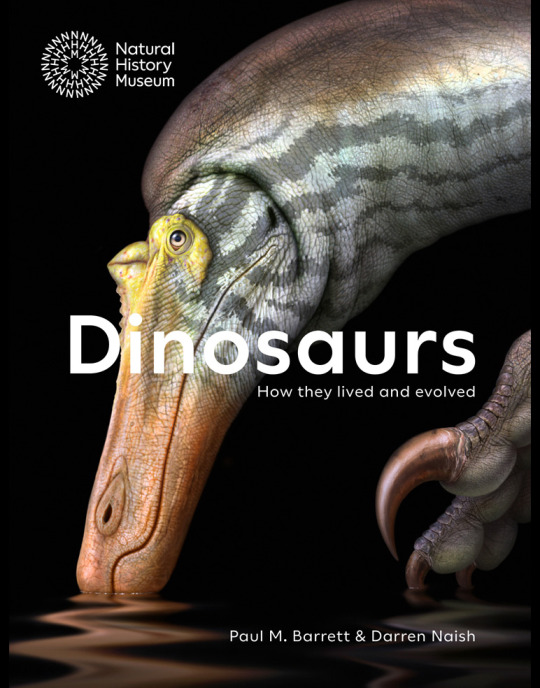
My 25 years of palaeoart chronology…
From 2023, here's my cover art for the third edition of DINOSAURS, HOW THEY LIVED AND SURVIVED, the official dinosaur book from the Natural History Museum, London, by Naish and Barrett.
#Art#Painting#PaleoArt#PalaeoArt#SciArt#SciComm#DigitalArt#Illustration#Dinosaurs#Reptiles#Palaeontology#Paleontology#Spinosaurs#Spinosaurus#Baryonyx#Ceratosuchops#JurassicWorld
124 notes
·
View notes
Text

Iguanodon bernissartensis feels it's time to get down to business in Belgium during the Early Cretaceous
#dinosaur#illustration#paleoart#paleontology#paleoillustration#paleoblr#palaeoblr#art#palaeontology#dinosauria#dinosaur art#dinosaurs#ornithischians#ornithopod#iguanodon#paleoartist#palaeoart#sci art#scicomm#early cretaceous#illustrators on tumblr#belgium#prehistoric planet#evolution#natural history#earth history
764 notes
·
View notes
Text
You know what I hate about the internet? Sometimes people will just lazily slap a “citation” on an infographic and trust that they’ll be completely taken at their word and nobody is going to dig deeper. And it works all the time. As an example, please look at this photo someone posted to dispute my assertion that garlic can be toxic to dogs.
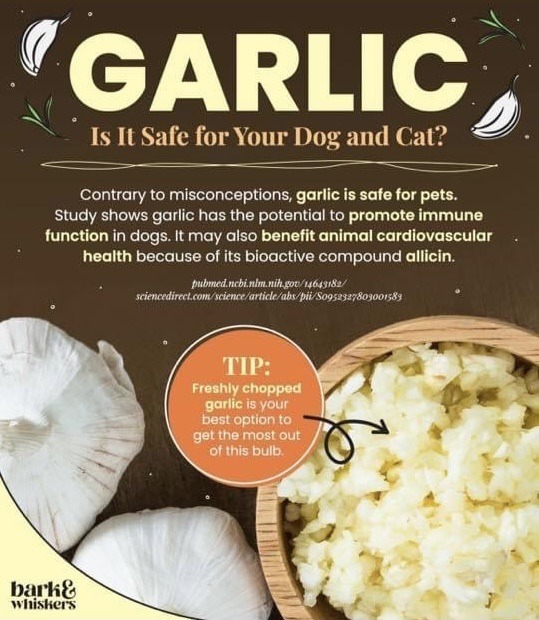
Okay well, kind of a pain to manually type in that link but obviously I am going to look into this study that is confident enough to recommend people feeding their dogs garlic. So here’s the article, kind of a weird journal choice for this graphic to reference from but looks like a legit (though 20 year old) study

Funny thing is, almost immediately this article acknowledges that garlic can indeed be toxic to dogs. The health benefits mentioned in the graphic are referring to human health, not canine. This section is literally in the introduction of the article and one of the first things you read. Emphasis here is mine.
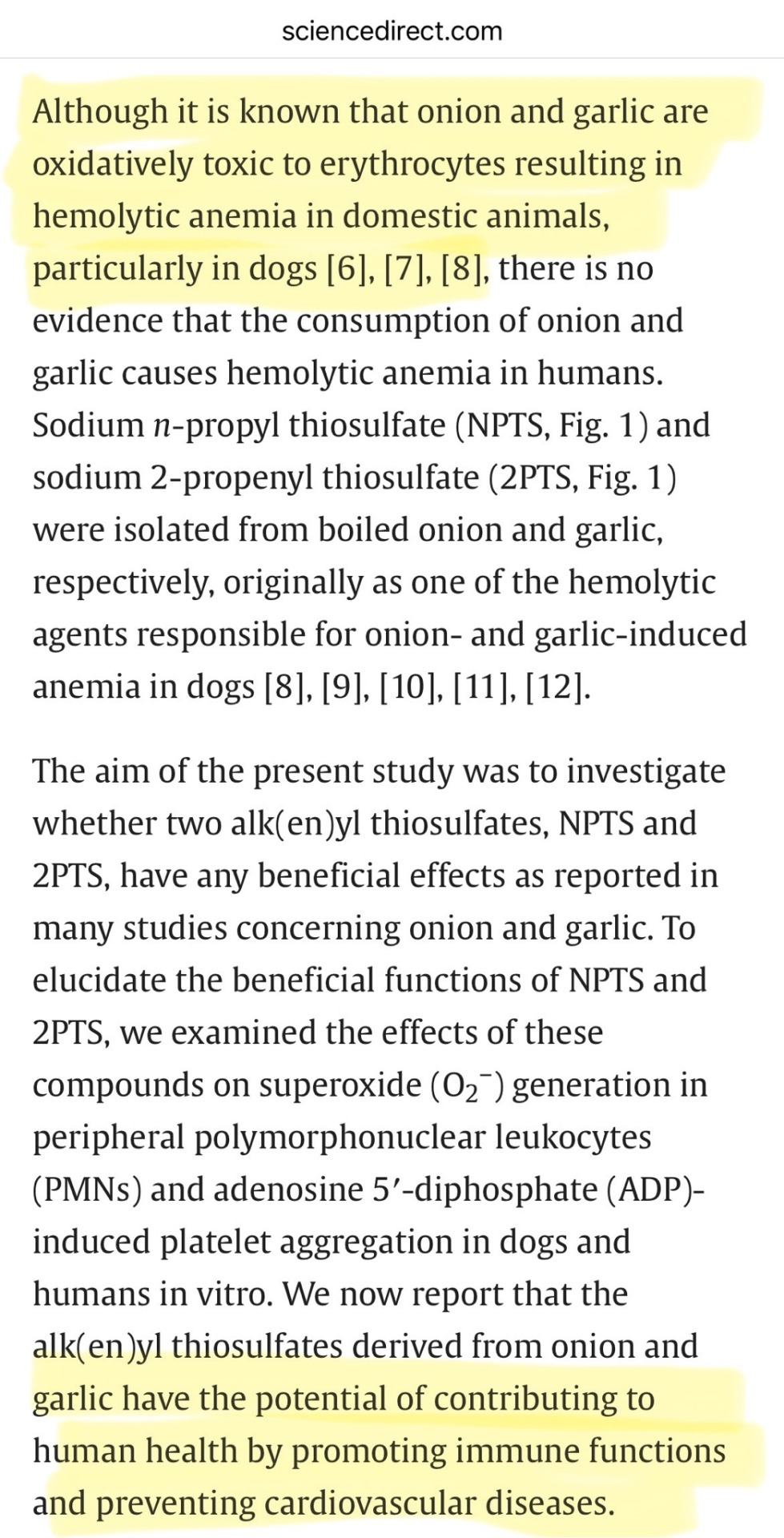
Crazy to me that someone would imply that this article encourages giving dogs garlic when it in fact immediately asserts that doing so has the potential to cause hemolytic anemia. The article does explore the anti-thrombotic effects of garlic components in dogs and humans, but by no means does it say that “contrary to misconceptions garlic is safe for pets”. It is dishonest to assert this in an infographic. However the creator of the image correctly assumed nobody would check, because the person who posted it took it as fact without further investigation.
I am begging you to be skeptical. Check your sources. Check their sources. Check my sources. Learn how to dig deeper and exercise that muscle as much as you can, especially on the internet. You will be absolutely shocked how much misinformation is casually stated and received as pure fact.
#scicomm#vetblr#veterinary medicine#I already know people are going to say they like giving their dogs garlic and will continue to do so- whatever pls just don’t tell me 😭#sorry if the link doesn’t work for you you may need access#dogs#pets#science literacy#biology
6K notes
·
View notes
Text










I would like to thank in this post every artist who joins in nearly every Friday for Flocking Together, a weekly format we host on Twitch and Discord!
It's a stream in which we draw together 4 creatures from deep time. These have been voted on beforehand and each are done within 20 min. Before we draw it we discuss the animals in question, share references and talk about things to keep in mind about them. After the drawings are done people are free to post them and I review them and if you want to post them afterwards I am delighted to repost them, no matter how rough they might be. Here a few examples of the images that are created on stream by artists like @barghest-land, @bornulhuu, @petitepaleoartist, @cypressure, @impulseimpact, @aberrantologist, @katborg82, @the-dragon-girl-27, @veloci-raptor or myself If you wanna join in you can so on Twitch or Discord: https://www.twitch.tv/paleostream
410 notes
·
View notes
Text
So, here's the thing: ranching in the United States was developed in part by exterminating any large animals that could pose a threat to cattle and other livestock, whether through predation or competition for food. That includes wolves, bears, cougars, bison, etc. While it's likely there was someone along the line who tried to coexist with these wild animals while raising livestock, the prevailing solution was to kill "nuisance" species, whether by shooting, trapping, or poisoning them en masse. These animals were wiped out from much of their native range in the lower 48 states by the early 20th century, and their more recent return represents a reckoning with the way we have used and abused the land since.
Now that we have more understanding of the ecological importance of every native species that exists in an ecosystem, there's no excuse to keep defaulting to killing wolves and other predators. Conservationists have offered ranchers a wide variety of solutions to protect their stock, from wolf-proof fences and hazing protocols to livestock guardian dogs. Ranchers can request financial compensation in many Western states for wolf-killed livestock and other losses, though not every rancher wants to differentiate between a cow killed by wolves, and one that died of other causes but was scavenged by wolves postmortem. And, unsurprisingly, some ranchers file fraudulent claims to game the system.
But there also remains the attitude that ranchers should be able to let their cattle run wherever they want on private or public land, and not have to monitor them or create adequate barriers against predators. The entitlement they feel to enormous areas of land, to include public lands that are supposed to be for everyone's use, has its roots in the assumption that "taming the land" for economic profit is more important than any other use. They want any potential threat to be preemptively removed for their convenience, no matter the ecological cost--or human cost, for that matter. Don't forget that every ranch in the West was once the homeland of indigenous people who were, more often than not, forcibly and violently removed so the ranchers' predecessors could move in with their livestock.
It's time for ranchers to accept that they're going to have to adjust to the return of native animals that have lived in these ecosystems for thousands of years. It is already beyond generous that states are willing to pay ranchers for lost cattle. They need to return the favor by working with conservationists to find solutions that reduce predation without just shooting the predatory species native to their region. Ranching as it stands today can only be achieved by the elimination of native animals from the land, but it's not the only way to successfully raise livestock in wild areas. It's time for new solutions that benefit both the cattle and the wildlife alike.
#wolves#gray wolves#farming#ranching#conservation#shoot shovel shut up#environment#nature#wildlife#animals#ecology#scicomm#cattle#habitat restoration#restoration ecology#rewilding
2K notes
·
View notes